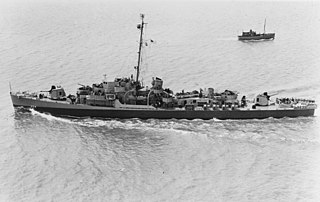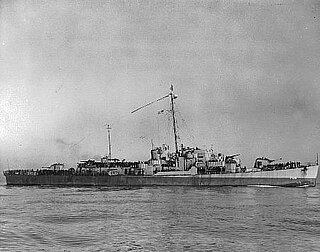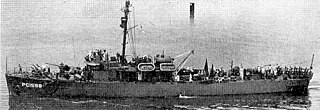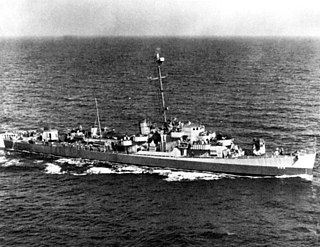
USS Fletcher (DD/DDE-445), named for Admiral Frank Friday Fletcher, was the lead Fletcher-class destroyer, and served in the Pacific during World War II. She received fifteen battle stars for World War II service, and five for Korean War service.

USS Kephart (DE-207/APD-61) was a Buckley-class destroyer escort in service with the United States Navy from 1944 to 1947. After spending 20 years in reserve, she was transferred to Republic of Korea Navy and served another 18 years as Kyong Puk (PF-82) until she was struck in 1985.

USS Rudderow (DE-224) was the lead ship of her class of destroyer escorts, in service with the United States Navy from 1944 to 1947. After spending decades in reserve, she was sold for scrap in 1970.

USS Foote (DD-511), a Fletcher-class destroyer, was the third ship of the United States Navy to be named for Rear Admiral Andrew Hull Foote (1806–1863), who served during the Civil War.

USS Robinson (DD-562), a Fletcher-class destroyer, was the second ship of the United States Navy to be named for Captain Isaiah Robinson, who served in the Continental Navy.

USS Drayton (DD-366) was a Mahan-class destroyer in the United States Navy before and during World War II. She was the second ship named for Captain Percival Drayton, a career naval officer who served during the American Civil War.

The fourth USS Flusser (DD-368) was a Mahan-class destroyer in the United States Navy before and during World War II. She was named for Charles W. Flusser.

USS Holt (DE-706) was a Rudderow-class destroyer escort of the United States Navy. She was named after William Mack Holt.

USS Jobb (DE-707) was a Rudderow-class destroyer escort in service with the United States Navy from 1944 to 1946. She was sold for scrap in 1970.
USS PC-1119 was a PC-461-class submarine chaser built for the United States Navy during World War II. She was later renamed Greencastle (PC-1119), after Greencastle, Indiana and Greencastle, Pennsylvania, but never saw active service under that name.

USS Eichenberger (DE-202), a Buckley-class destroyer escort of the United States Navy, was named in honor of Ensign Charles Emil Eichenberger Jr. (1920–1942), who was killed in aerial combat on 12 September 1942 during the attack on the Solomon Islands

USS Excel (AM-94) was an Adroit-class minesweeper of the United States Navy. Laid down on 19 December 1941 by the Jakobson Shipyard, Inc., Oyster Bay, Long Island, New York, launched on 10 May 1942, and commissioned on 11 December 1942. The ship was reclassified as a submarine chaser, PC-1598 on 1 June 1944.

USS Key (DE-348) was a John C. Butler-class destroyer escort in service with the United States Navy from 1944 to 1946. She was scrapped in 1972.
USS Johnnie Hutchins (DE-360) was a John C. Butler-class destroyer escort acquired by the U.S. Navy during World War II. The primary purpose of the destroyer escort was to escort and protect ships in convoy, in addition to other tasks as assigned, such as patrol or radar picket. She served in the Pacific Ocean, and, post-war, she returned home with a Navy Unit Commendation awarded to her for her battle with Japanese midget submarines on 9 August 1945.

USS Richard M. Rowell (DE-403) was a John C. Butler-class destroyer escort acquired by the United States Navy during World War II. The primary purpose of the destroyer escort was to escort and protect ships in convoy, in addition to other tasks as assigned, such as patrol or radar picket. During her career she earned six battle stars to her credit.

USS Douglas A. Munro (DE-422) was a John C. Butler-class destroyer escort acquired by the U.S. Navy during World War II. The primary purpose of the destroyer escort was to escort and protect ships in convoy, in addition to other tasks as assigned, such as patrol or radar picket.

USS Formoe (DE-509) was a John C. Butler-class destroyer escort in service with the United States Navy from 1944 to 1946 and from 1951 to 1957. She was then transferred to Portugal, where she served as NRP Diogo-Cão (F-333) until 1968. She was scrapped in 1970.

USS Day (DE-225) was a Rudderow-class destroyer escort in the United States Navy during World War II.

USS Chaffee (DE-230) was a Rudderow-class destroyer escort in the United States Navy during World War II.

USS LST-911 was an LST-542-class tank landing ship in the United States Navy. Like many of her class, she was not named and is properly referred to by her hull designation.


















